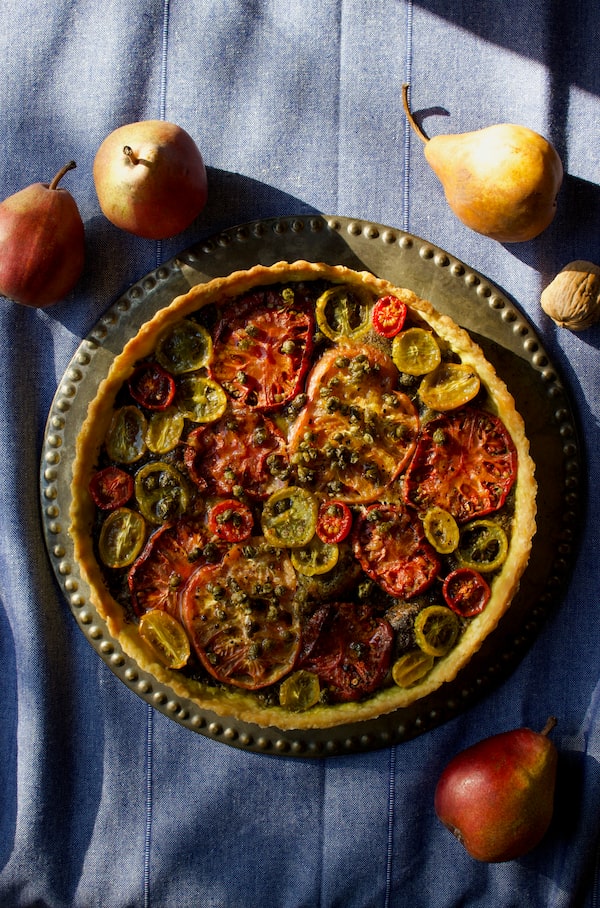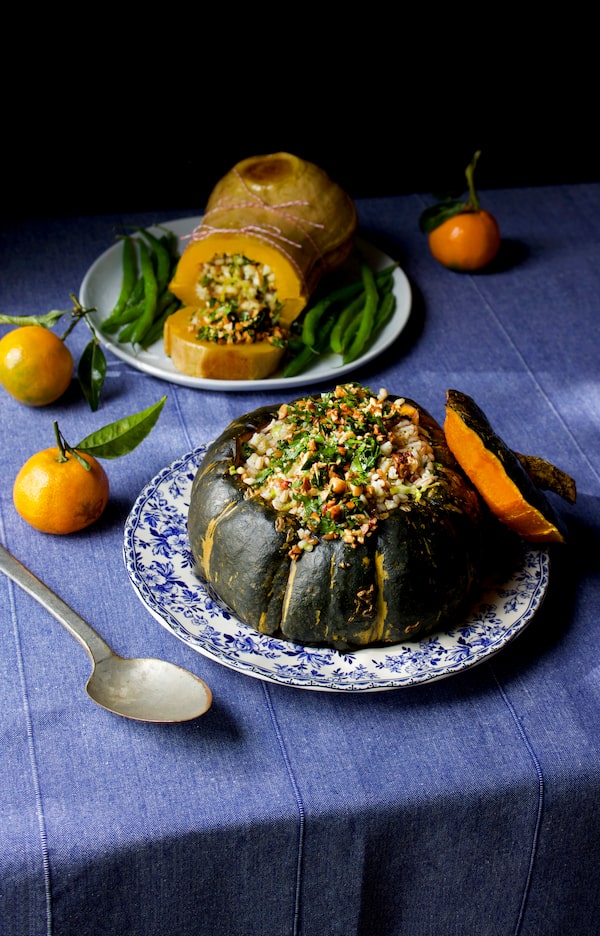Holiday feasts traditionally revolve around elaborate, larger-than-life roasts – turkey, ham, prime rib, crown roast of pork – something worthy of being presented Norman Rockwell-style at the dinner table, with vegetable side dishes relegated to the supporting cast. But there’s no reason plants can’t be put on a pedestal; they too can be treated with extra care during the holidays, whether roasted, wrapped in pastry or otherwise dressed up for a festive occasion. Bonus: Timing vegetables isn’t as tricky as pricey cuts of meat can be, and even the largest gourd won’t force you up early in the morning to stuff and get into the oven.
Lentil and mushroom Wellington with mushroom gravy

Julie Van Rosendaal/The Globe and Mail
Serves 8 or more
Just about any combination of vegetables, grains and pulses can be rolled up in a piece of puff pastry and baked. The brand of pastry you buy will determine the size and shape of your Wellingtons: Some come prerolled, others must be rolled out. A 10-inch square is common, but don’t worry if yours happens to be prerolled to a different size.
- 1/4 cup + 1 tablespoon butter or vegan margarine (divided, optional)
- Olive or other vegetable oil, for cooking
- 1 medium onion, finely chopped
- 1-1½ pounds fresh mushrooms (button, cremini, brown, oyster or a combination)
- 1-2 garlic cloves, crushed
- 2 teaspoons fresh thyme leaves
- 1-2 teaspoons chopped fresh rosemary
- Salt and freshly ground pepper, to taste
- 1½ cups cooked or canned, drained lentils
- 4 ounces soft goat cheese (optional)
- 1 package puff pastry, thawed
- 1 egg (optional)
- 2 tablespoons all-purpose flour
- 1½-2 cups vegetable, mushroom or onion stock
- 1 teaspoon soy sauce
- 2 tablespoons nutritional yeast (optional)
Preheat the oven to 400 F. Put ¼ cup butter into a large skillet set over medium-high heat, add a drizzle of oil and sauté the onion for 4-5 minutes, or until soft. Roughly chop and add the mushrooms along with the garlic, thyme and rosemary and cook, seasoning with salt and pepper, until the mushrooms start to turn golden and the excess liquid has evaporated. Transfer to a bowl, reserving a couple spoonfuls if you like to stir into the gravy, and stir in the lentils. Set aside to cool completely. (The filling can be made up to three days ahead, and refrigerated.)
Unroll your thawed pastry, or cut the block in half and roll each piece into a 10x10-inch square. If you’re using it, spread or drop the goat cheese in spoonfuls down one third of each piece of pastry. Spoon the mushroom-lentil filling down the middle. Fold the goat cheese side over the mushrooms, and roll it over to form a log. Transfer to a parchment-lined sheet (if you have room, you could assemble them on the parchment-lined sheets) and tuck under the ends.
In a small dish, lightly beat the egg with a spoonful of water. Brush over the Wellingtons and lightly score the top with a sharp knife, allowing it to slice through in a few places. (Alternatively, cut a few slashes in the top.) Bake for 25-30 minutes, or until deep golden.
Meanwhile, return the skillet to the stovetop over medium-high heat and sprinkle the flour over the bottom of the pan. Let it sit for a minute, until it starts to turn golden. (Don’t walk away – it will darken quickly.) Whisk in the remaining tablespoon of butter (or a tablespoon of oil), and the stock. Bring to a simmer, whisking constantly, until the gravy bubbles and thickens. Whisk in the soy sauce and nutritional yeast (if using) and continue to cook, stirring often, until the gravy darkens and reduces. Stir in any mushrooms you set aside.
Serve the Wellington in slices, drizzled with gravy.
Tomato tart with olive oil crust and crispy capers

Julie Van Rosendaal/The Globe and Mail
Serves 12-16
Because just about everything goes well with tomatoes, you can customize this tart however you like. Spread the pastry with a thin layer of pesto or olive tapenade, caramelized onions, ricotta or soft goat cheese, bits of Brie or sharp cheddar or Parmesan. To make a cheesy pastry, toss a handful of grated extra-aged Gouda, Parmesan or Gruyère into the flour and salt before adding the oil and water.
Pastry
- 1⅓ cups all-purpose flour
- ¼ teapsoon fine salt
- ⅓ cup olive oil
- ¼ cup water
Filling
- ⅓ cup pesto or olive tapenade or ½ cup ricotta
- 1 pound tomatoes, preferably in a range of colours
- Salt and freshly ground pepper, to taste
- Freshly grated Parmesan cheese (optional)
- Olive oil, for drizzling
- 2 tablespoons capers
- 2-4 tablespoons canola or olive oil
Preheat the oven to 400 F.
In a medium bowl, stir together the flour and salt. Add the oil and water and stir just until the dough comes together.
On a lightly floured surface, roll the dough out into about an 11-inch circle, transfer to a 10-inch tart pan and gently press into the bottom and up the sides. Spread with pesto, tapenade or ricotta. Slice large tomatoes about 1/4-inch thick, halve cherry or grape tomatoes and arrange them over the bottom, placing them close together or overlapping them slightly. Sprinkle with salt and pepper, scatter with Parmesan if you like, and drizzle with olive oil.
Bake for 25-30 minutes, or until the crust is golden and tomatoes are soft. Pat the capers dry between two paper towels, heat the oil in a small skillet over medium-high heat (you should have a depth almost equal to the size of a caper) and cook the capers for about 2 minutes, until crisp. Transfer to paper towel to drain. Scatter over the tart just before serving.
Stuffed winter squash with hazelnut-clementine gremolata

Julie Van Rosendaal/The Globe and Mail
Serves 8 or more
Just about any vegetable can be roasted along with the whole squash, then chopped into the filling. Try wedges of onion or fennel, diced rutabaga or celeriac root, or halve and roast the Brussels sprouts instead of adding raw slices to the grains. If you like, add some soft crumbled goat cheese or grated extra-old cheddar, Gouda or Parmesan to the grain mixture.
- 1 medium kabocha, hubbard or butternut squash
- 2 1-inch slices cauliflower (or 2 cups florets)
- Olive, canola or other vegetable oil, for cooking
- Salt and freshly ground pepper, to taste
- Hazelnut-clementine gremolata
- ½ cup whole hazelnuts
- ½ bunch flat-leaf parsley
- Grated zest of 1 clementine
- 1 garlic clove, finely crushed
- ¼-⅓ cup extra-virgin olive oil
Stuffing
- 1 cup farro, wheat berries, wild rice or pearl or pot barley (or a combination)
- 2-3 cups vegetable stock or water
- 4-6 Brussels sprouts or 2-3 kale leaves, thinly sliced (discard stems)
- ¼ cup dried cherries or cranberries or golden raisins
- 1-2 green onions, thinly sliced
Clementine Vinaigrette
- Juice of 1 clementine (or 3-4 tablespoons orange juice)
- 1 tablespoon white wine vinegar
- 1 teaspoon honey or pure maple syrup
- 1/4 teaspoon garam masala (optional)
- ¼-⅓ cup olive oil
Preheat the oven to 400 F. If you’re using a round squash, cut out and remove the lid as if you were about to carve a pumpkin, and scoop out the seeds and stringy bits. If you’re using butternut, cut it in half lengthwise and scoop out the seeds. Place on a baking sheet along with the cauliflower, drizzle everything with oil, rub all over the surface of the vegetables with your fingers, sprinkle with salt and roast for 30-45 minutes, or until soft and turning golden. (With its solid neck, butternut might need some extra time, depending on its size and shape.)
Place the hazelnuts for the gremolata in a small pan and put them into the oven along with the squash for about 10 minutes, or until fragrant. Rub them in a dishtowel to get rid of their skins, and roughly chop. Place them in a bowl, roughly chop the parsley (discard the stems), and add it to the bowl with the hazelnuts. Add the clementine zest, garlic and a pinch of salt, and stir in enough oil to make a loose sauce.
Meanwhile, cook the farro, wheat berries, rice or barley in stock or water until the grains are just tender, but still have a little chew; 30-40 minutes for barley or wild rice, 30-60 for farro or wheat berries (or according to package directions). Drain any excess moisture, transfer to a bowl and add the Brussels sprouts or kale, dried fruit and green onion. Chop and add the cauliflower to the mix.
To make the vinaigrette, whisk or shake together the juice, vinegar, honey, garam masala and oil; season with salt and pepper, drizzle over the warm grains (use as much or as little as you like), and toss to combine.
If you’re using butternut, scoop out the soft inner flesh, leaving about ¾-inch of flesh in the shell. Spoon the grainy stuffing into the squash, mounding it at the top. If you’re using butternut, place the two filled halves side by side, like an open book, then close them together and carefully tie around the two halves with kitchen string.
Serve open-topped squash by the large spoonful, scooping out some of the soft squash with each serving, or in wedges; cut stuffed butternut into inch-thick slices, and top either with hazelnut gremolata.
How to veganize classic sides
Mashed potatoes Squeeze cloves of roasted garlic into boiled Yukon gold potatoes as you mash them, along with vegan butter, salt and pepper. To roast garlic, wrap whole heads in foil and bake directly on the oven rack for about an hour, while something else is baking. Store in the fridge until you’re ready to use it.
Sweet potatoes Bake small ones whole on a rimmed sheet in the oven until soft; reduce apple cider with a slice of ginger and a cinnamon stick to a syrupy consistency to drizzle over top.
Brussels sprouts Instead of roasting them with bacon, toss halved sprouts in olive oil and roast at 425 F until golden, then toss with a drizzle of balsamic vinegar and honey, and a pinch of salt and chili flakes. Or halve and thinly slice raw sprouts and toss with chopped pears or apples and a lemony vinaigrette; top with toasted walnuts.
Gravy The browned bits from a tray of roasted vegetables makes the perfect starting point for a pan of gravy. There should be some residual oil on the pan, too – if not, add a drizzle, sprinkle with a spoonful flour and whisk in vegetable or onion stock on the stovetop until it bubbles and thickens.



